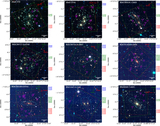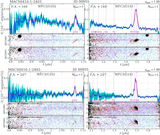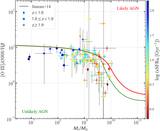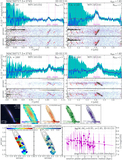Image Details

Caption: Figure 9.
Metallicity gradient as a function of stellar mass for high-z and local star-forming galaxies. As in Figure 8, our measurements are represented by three types of symbols regarding three z bins colored-coded in sSFR, whereas high-z ground-based measurements with similar resolution are denoted by magenta squares. For comparison, we also show the median measurements with a 1σ interval of local measurements (Belfiore et al. 2017; Bresolin 2019), the 2σ spread of the FIRE simulations (Ma et al. 2017), and two mass dependencies derived from the EAGLE simulations assuming different feedback settings (Tissera et al. 2019). Combining all available high-z gradients measured at sufficient spatial resolution (≲kpc), we obtain a weakly negative mass dependence over 4 orders of magnitude in ﹩{M}_{* }﹩, Δlog(O/H)/﹩{\rm{\Delta }}r\,[\mathrm{dex}\,{\mathrm{kpc}}^{-1}]﹩ = (−0.020 ± 0.007) + (−0.014 ± 0.008) ﹩\mathrm{log}({M}_{* }/{10}^{9.4}\,{M}_{\odot })﹩, with the intrinsic scatter being σ = 0.060 ± 0.006. The thin tan lines mark 100 random draws from the linear regression. This observed mass dependence is in remarkable agreement with the predictions of the FIRE simulations. However, as shown in Table 2, we also observe an increase of the intrinsic scatter from high- to low-mass systems not captured by theoretical predictions.
Copyright and Terms & Conditions
© 2020. The American Astronomical Society. All rights reserved.













